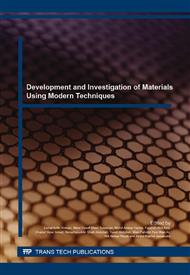p.389
p.394
p.399
p.404
p.410
p.416
p.421
p.427
p.432
Development of α-Fe2O3 as Adsorbent and its Effect on CO2 Capture
Abstract:
Iron oxide (α-Fe2O3) as adsorbent was no longer new in CO2 adsorption studies. However, its contributions in the industry still in limited wherein lack of convincing results of quantifying of adsorbed CO2. This work presents an analysis for α-Fe2O3 was prepared by simple mixing method with identified the adsorption capacity that applied in CO2 capture. The synthesized α-Fe2O3 from different concentrations of precursor were analyzed using XRD, N2 adsorption-desorption isotherms with BET and BJH method, TEM, FTIR, CO2 adsorption at 298 K, CO2-TPD and TGA-DTG. It was noted that 2M concentration of precursor (s2M) with highest crystallite peaks shows highest surface area among all samples which indicative of well generated pores. The different concentration of precursor was found generated more porosity rather than particle size according to TEM micrograph. The sphere shape crystallite particle with high surface area (50.5 m2/g) and porosity were desirable properties in CO2 adsorption. Consequently, physically adsorbed CO2 with adsorption at 298 K was highest with adsorption capacity of at 17.0 mgCO2/gadsorbent. Finally, chemically adsorbed CO2 was successfully identified from CO2–TPD analysis with adsorption capacity of 0.19 mgCO2/gadsorbent and 1.31 mgCO2/gadsorbent at maximum desorption temperature of 375 °C and 749 °C respectively.
Info:
Periodical:
Pages:
421-426
Citation:
Online since:
January 2016
Keywords:
Price:
Сopyright:
© 2016 Trans Tech Publications Ltd. All Rights Reserved
Share:
Citation:


